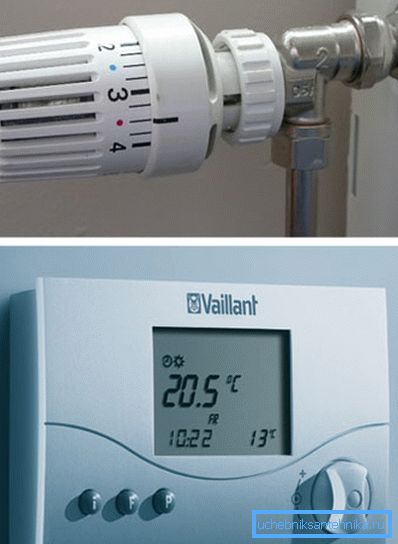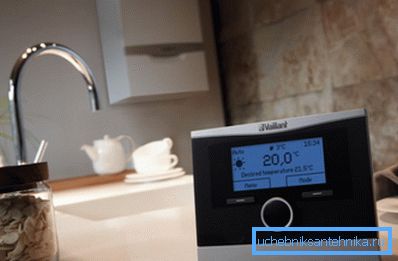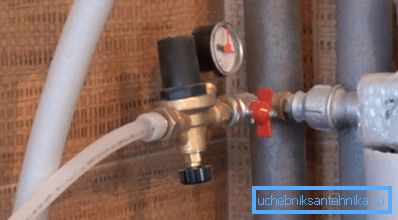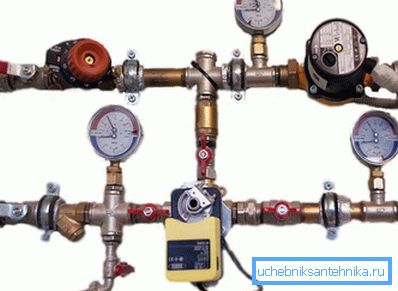Why do we need automatic heating systems in a private house
Having decided to put an autonomous heating system in the house, most of the owners are counting on automation, which simplifies its operation, regardless of whether they understand the technical side of the device or not. In their opinion, the system should clearly carry out the tasks entrusted to it, the main of which is to release the owner from the routine regulation of temperature.
However, not everyone is ready to give their comfort into the hands of the “mechanical mind” and in the old manner they want to control everything with their own hands. Our task today is to explain the advantages of the automatic heating control system, and to talk about its features.

What do we know about automation
Under this name usually imply some number of different devices, the purpose of which is to monitor the operation of the heating boiler. In fact, the very name of the process suggests that the complex of devices allows performing various jobs without an operator.
The instruction recommends setting the required parameters independently, and the system will adhere to them, which is very convenient and does not take up free time. As a result, the control takes place as accurately as possible and without errors, which cannot be ruled out under the “human factor”.

Today, you can automate any process, so heating is no exception in this regard. In addition, automation can be applied to the whole scheme at once, as well as to its individual elements, for example, radiators.
As mentioned above, automatic heating control is a control over the temperature in the boiler and inside the premises. This is its main function, which is why the most questions arise for instruments.
The market is saturated with a fairly large range of regulating and controlling devices, differing in functionality, performance and accuracy of readings. Therefore, we consider this question in more detail.

Thermostatic valve
- Designed to control and adjust the temperature in each room of the house.
- Installation is made on the battery or contour of a heat-insulated floor of heating.
- To turn the device into operation, it is enough to turn its thermal head on which there are digits of the required temperature.
- The rest of the work is done automatically, so when the air temperature in the room decreases, the valve opens the flow of coolant to the radiator, closes it if it is exceeded.
- The operation of the circuit does not depend on the temperature in the heat generator and the type of domestic boiler of the heating system.
- Most often the equipment is used with gas, liquid fuel and solid fuel heating equipment heating medium. In the latter case, this is most appropriate, since it is difficult or impossible to adjust the temperature in the heat generator.

When choosing this automatic device, please note that it is not intended to save. Explain below:
| Power | When installing a thermostatic valve, the heat output of the radiator immediately increases by about 15%. Therefore, if it is not installed, the heater can be selected with lower power. In fact, we will have to purchase a battery at a higher price. |
| Boiler operation | The heat generator will have to work in a mode that is not very comfortable for it, which will affect:
He will need to turn on and off several times a day, which is much worse than if he had to work in the same mode. With solid fuel heat generators even more problems. It is almost impossible to adjust the fuel supply in them, so there is a danger of boiling the coolant. |
| Human factor | To save energy, you will have to reduce its temperature when you are not at home. There are two ways to do this:
|
The price of a quality thermoventil cannot be low. If you install it on all radiators in the house, the amount will be pretty serious.

Room temperature control
- One of the modern automation devices for heating.
- Mounted on the wall in the room and represents a whole range of devices:
- switching fuel on and off (for electric and gas boilers);
- regulating the work of the circulation pump in systems with solid fuel unit.

We define the advantages of this automation:
- The temperature of the air in the room is controlled, but not the coolant in the radiators. Therefore, there are no sudden changes in temperature.
- The boiler will not switch on and off frequently. Due to this, it is possible to reduce the cost of energy by almost 30%.
- The controller is programmable. Therefore, it is not difficult to set a minimum temperature for a week if you need to leave home. Before your return, the system can warm up the air in the room to a normal level in an hour.
Tip: we recommend using this method, since each lowered degree can give 6% fuel economy.

- Regulators with two sensors - in the house and on the street are able to control the mode in the room from the outside temperature. They are called weather-dependent, and their value can be 6 times higher than usual.
- This automation can be controlled not only manually, but also with the help of SMS messages or via the Internet.
Tip: Automation of heating systems for residential buildings - related articles, detailed diagrams and recommendations for self-installation can be found on our portal.
Thermal fan with room regulator
An interesting option, which should be discussed in more detail, in order to understand whether it is possible to gain from such a combination in the form of savings in heating costs.
Experts say that costs will be significantly reduced. This will happen not only due to lower energy consumption, but also through the acquisition of low-cost thermostatic valves.

In this case, it is necessary to properly distribute the functions between the devices, based on the importance of each:
- room controller should be used as the main element controlling and regulating the operation of the heat generator. Therefore, the main adjustment will depend on it;
- Thermal vents are needed as additional equipment that can be used to adjust the temperature in the rooms., based on the conditions created inside each.
Conclusion
Automation of the heating system makes it possible to get rid of the constant monitoring of the temperature in the boiler, allows you to configure the necessary comfortable thermal mode in each room. Thermal ventilation and room regulators are used to achieve such goals, both separately and in combination.
In the latter case, the savings on the operation of the heating system is more substantial. Video in the article will provide an opportunity to find additional information on the above topic.